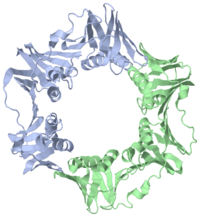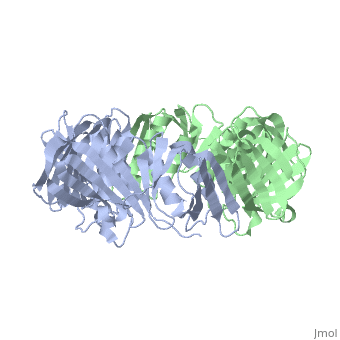Polymerase III homoenzyme beta subunit
From Proteopedia
(→Introduction) |
(→Introduction) |
||
| Line 7: | Line 7: | ||
<StructureSection load='2pol' size='350' side='right' caption='Structure of Polymerase III Holoenzyme beta subunit (PDB entry [[2pol]])' scene=''> | <StructureSection load='2pol' size='350' side='right' caption='Structure of Polymerase III Holoenzyme beta subunit (PDB entry [[2pol]])' scene=''> | ||
== Structure == | == Structure == | ||
| - | The beta subunit binds DNA by forming a ring around the DNA helix, essentially acting as a sliding clamp, also known as a beta clamp. This conformation allows the enzyme to move along the DNA structure without diffusing away, thereby increasing the processivity and rate of nucleotide polymerization. The beta complex consists of a <scene name='Polymerase_III_homoenzyme_beta_subunit/Dimer/1'>dimer of monomers</scene> that form a donut-type structure with an <scene name='Polymerase_III_homoenzyme_beta_subunit/Outer_diameter/1'>~80A total diameter</scene>. This creates an inner ring of approximately | + | The beta subunit binds DNA by forming a ring around the DNA helix, essentially acting as a sliding clamp, also known as a beta clamp. This conformation allows the enzyme to move along the DNA structure without diffusing away, thereby increasing the processivity and rate of nucleotide polymerization. The beta complex consists of a <scene name='Polymerase_III_homoenzyme_beta_subunit/Dimer/1'>dimer of monomers</scene> that form a donut-type structure with an <scene name='Polymerase_III_homoenzyme_beta_subunit/Outer_diameter/1'>~80A total diameter</scene>. This creates an <scene name='Polymerase_III_homoenzyme_beta_subunit/Dna_binding_inner_ring_diamete/1'>inner ring of approximately 35 A</scene>, in which A- and B-DNAs have room to bind. The dimeric ring is a pseudo-symmetrical six pointed star, with each monomer made up of three structurally similar domains. These domains align head to tail to form the ring shape. The inner surface of the ring is <scene name='Polymerase_III_homoenzyme_beta_subunit/Positively_charged_inner_ring/1'>positively charged</scene> in order to bind to the phosphate backbone of the DNA. |
== Function == | == Function == | ||
Model studies of B-DNA binding this enzyme suggest that the beta subunit is specifically designed to limit DNA associations in order to move freely along the helix, ensuring high processivity. This decreased association with DNA is due to the fact that the protein alpha helices do not actually enter the major and minor grooves of the DNA in favor of simply spanning over them. In solution, this ring structure is highly dynamic. The beta clamp in the Pol III holoenzyme must be reloaded onto the template strand of DNA at a rate of once per second, in order to achieve the observed rate of 1,000 nucleotides per second observed in E. Coli DNA. This reloading is done by the gamma subunit of the holoenzyme, also known as the clamp loader. After the beta subunit is bound to the DNA, the core of the holoenzyme dissociates from the clamp loader to allow for DNA replication. After replication is complete, the beta subunit begins to dissociate from the DNA, with domain I dissociating from domain III. When Pol III encounters the previously synthesized Okazaki fragment, the beta subunit dissociates from the DNA and is ready to bind subsequent templates. | Model studies of B-DNA binding this enzyme suggest that the beta subunit is specifically designed to limit DNA associations in order to move freely along the helix, ensuring high processivity. This decreased association with DNA is due to the fact that the protein alpha helices do not actually enter the major and minor grooves of the DNA in favor of simply spanning over them. In solution, this ring structure is highly dynamic. The beta clamp in the Pol III holoenzyme must be reloaded onto the template strand of DNA at a rate of once per second, in order to achieve the observed rate of 1,000 nucleotides per second observed in E. Coli DNA. This reloading is done by the gamma subunit of the holoenzyme, also known as the clamp loader. After the beta subunit is bound to the DNA, the core of the holoenzyme dissociates from the clamp loader to allow for DNA replication. After replication is complete, the beta subunit begins to dissociate from the DNA, with domain I dissociating from domain III. When Pol III encounters the previously synthesized Okazaki fragment, the beta subunit dissociates from the DNA and is ready to bind subsequent templates. | ||
Revision as of 10:33, 8 November 2012
Contents |
Introduction
The of the Polymerase III holoenzyme is one of ten subunits in the Pol III multisubunit complex, which catalyzes the synthesis of both the leading and lagging strands of DNA in E. Coli. While the core Pol III enzyme (consisting of the alpha, sigma and theta subunits) dissociates from the DNA after replicating approximately 12 residues, the holoenzyme complex has a processivity of more than 5,000 residues. The increase in replication processing is due to the beta subunit.
| |||||||||||
About this Structure
2pol is a 2 chain structure with sequence from Escherichia coli. The June 2012 RCSB PDB Molecule of the Month feature on Sliding Clamps by David Goodsell is 10.2210/rcsb_pdb/mom_2012_6. Full crystallographic information is available from OCA.
See Also
Reference
- Kong XP, Onrust R, O'Donnell M, Kuriyan J. Three-dimensional structure of the beta subunit of E. coli DNA polymerase III holoenzyme: a sliding DNA clamp. Cell. 1992 May 1;69(3):425-37. PMID:1349852
- Indiani C, O'Donnell M. The replication clamp-loading machine at work in the three domains of life. Nat Rev Mol Cell Biol. 2006 Oct;7(10):751-61. Epub 2006 Sep 6. PMID:16955075 doi:10.1038/nrm2022


